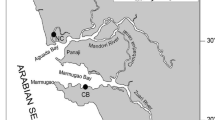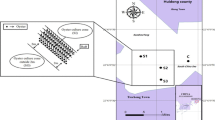Abstract
In order to compare with and assess the metal-accumulating ability of the soldier crab (Mictyris brevidactylus), the concentrations of copper (Cu), zinc (Zn), nickel (Ni), lead (Pb) and cadmium of ambient water and the Pacific oyster (Crassostrea gigas) were investigated. Seawater, soldier crabs and Pacific oysters were simultaneously collected from the Changhua coastal area, located in West-Central Taiwan. The Pacific oyster and stream results proved that site B is contaminated by Cu, Zn and Pb from streams B-1 and B-2. The highest Cu, Zn, Ni and Pb concentrations in soldier crabs appeared at site B, and significant differences in the accumulated concentrations of Cu, Pb, Zn and Ni in soldier crabs were found between the sites tested. The highest bioconcentration factors of Cu, Zn, Ni and Pb in soldier crabs appeared at site B, indicating that the soldier crab can accumulate Cu, Zn and Pb to the same degree as the Pacific oyster. In fact, soldier crabs can accumulate more Ni than Pacific oysters, better reflecting the conditions of the ambient environment. These phenomena, as well as the fact that the soldier crab is able to accumulate relatively high levels of Cu, Zn, Pb and Ni, suggest that this crab is a potential biomonitor of Pb and Ni pollution in aquatic ecosystems.
Similar content being viewed by others
References
Blackmore, G., & Wang, W. X. (2004). The transfer of cadmium, mercury, methylmercury, and zinc in an intertidal rocky shore food chain. Journal of Experimental Marine Biology and Ecology, 307, 91–110.
Chan, K. W., Cheung, R. Y. H., Leung, S. F., & Wong, M. H. (1999). Depuration of metals from soft tissues of oysters transplanted from a contaminated site to clean sites. Environmental Pollution, 150, 299–310.
Chen, M. H. (2002). Baseline metal concentrations in sediments and fishes, and the determination of bioindicators in the subtropical Chi-ku Lagoon, S. W. Taiwan. Marine Pollution Bulletin, 44, 703–714.
Environmental Protection Administration of Taiwan (1998). Surface water classification and water quality standards. Taipei: Environmental Protection Administration of Taiwan latest revisions promulgated by Environmental Protection Administration, Taiwan, order on June 24, 1998.
Fukuda, Y. (1990). Early larval and postlarval morphology of the soldier crab, Mictyris brevidactylus Stimpson (Crustacea: Brachyura: Mictyridae). Zoological Science, 7, 303–309.
Fukui, Y., Wada, K., & Wang, C. H. (1989). Ocypodidae, Mictyridae and Grapidase (Crustacea: Brachyura) from some coasts in Taiwan. Journal of Taiwan Museum, 42, 225–238.
Gefford, A., Amiard, J. C., & Amiard-Triquet, C. (2002). Kinetics of metal elimination in oysters from a contaminated estuary. Comparative Biochemistry and Physiology, 131, 281–293.
Greenberg, A. E., Clesceri, L. S., & Eaton, A. D. (1992). Standard Method for the Examination of water and wastewaters (18th ed.). Washington, D.C.: APHA, AWWA, and WEF.
Han, B. C., & Hung, T. C. (1990). Green oyster caused by copper pollution on the Taiwan coast. Environmental Pollution, 65, 347–362.
Han, B. C., Jeng, W. L., Hung, T. C., Ling, Y. C., Shieh, M. J., & Chien, L. C. (2000). Estimation of metal and organochlorine pesticide exposures and potential health threat by consumption of oysters in Taiwan. Environmental Pollution, 109, 147–156.
Hardiman, S., & Pearson, B. (1995). Heavy metals, TBT, and DDT in the Sydney rock oyster (Saccostrea commercialis) sampled from the Hawkesbury River Estuary, NSW, Australia. Marine Pollution Bulletin, 30, 563–567.
Huang, J. F., Yu, H. P., & Takeda, M. (1992). A review of the Ocypodid and Mictyrid crabs (Crustacea: Decapoda: Brachyura) in Taiwan. Bulletin of the Institute of Zoology, Academia Sinica, 31, 141–161.
Lee, C. L., Chen, H. Y., & Chuang, M. Y. (1996). Use of oyster, Crassostrea gigas, and ambient water to assess metal pollution status of charting coastal area, Taiwan, after the 1986 green oyster incident. Chemosphere, 33, 2505–2532.
Lim, P. E., Lee, C. K., & Din, Z. (1995). Accumulation of heavy metals by cultured oysters from Merbok Estuary, Malaysia. Marine Pollution Bulletin, 31, 4–12.
Muncaste, B. W., Hebert, P. D. N., & Lazar, R. (1990). Biological and physical factors affecting the body burden of organic contaminants in fresh-water mussels. Archives of Environmental Contamination and Toxicology, 19, 25–34.
Oost, R. V. D., Beyer, J., & Vermeulen, N. P. E. (2003). Fish bioaccumulation and biomarkers in environmental risk assessment: a review. Environmental Toxicology Pharmacology, 13, 57–149.
Phillips, D. J. H., & Rainbow, P. S. (1993). Biomonitoring of trace aquatic contaminates. New York: Elsevier.
Rainbow, P. S. (1995). Physiology, physicochemistry and metal uptake—a crustacean perspective. Marine Pollution Bulletin, 31, 55–59.
Shih, J. (1995). Population density and annual activities of Mictyris brevidactylus in the Tanshui mangrove swamp of Northern Taiwan. Zoological Studies, 34, 96–105.
Silva, C. A. R., Rainbow, P. S., & Smith, B. D. (2003). Biomonitoring of trace-metal contamination in mangrove-lined Brazilian coastal systems using the oyster Crassostrea rhizophorae comparative-study of regions affected by oil, salt pond and shrimp farming activities. Hydrobiologia, 501, 199–206.
Silva, C. A. R., Rainbow, P. S., Smith, B. D., & Santos, Z. L. (2001). Biomonitoring of trace metal contamination in the Potengi Estuary, Natal (Brazil), using the oyster Crassostrea rhizophorae, a local food source. Water Research, 35, 4072–4078.
Tuna, A. L., Yilmaz, F., Demirak, A., & Ozdemir, N. (2007). Sources and distribution of trace metals in the Saricay Stream basin of southwestern Turkey. Environmental Monitoring and Assessment, 125, 47–57.
Xu, Q., & Pascoe, D. (1993). The bioconcentration of zinc by Gammarus pulex and the application of a kinetic model to determine bioconcentration factors. Water Research, 27, 1683–1688.
Author information
Authors and Affiliations
Corresponding author
Rights and permissions
About this article
Cite this article
Yeh, HC., Chen, IM., Chen, P. et al. Heavy metal concentrations of the soldier crab (Mictyris brevidactylus) along the inshore area of Changhua, Taiwan. Environ Monit Assess 153, 103–109 (2009). https://doi.org/10.1007/s10661-008-0340-4
Received:
Accepted:
Published:
Issue Date:
DOI: https://doi.org/10.1007/s10661-008-0340-4




